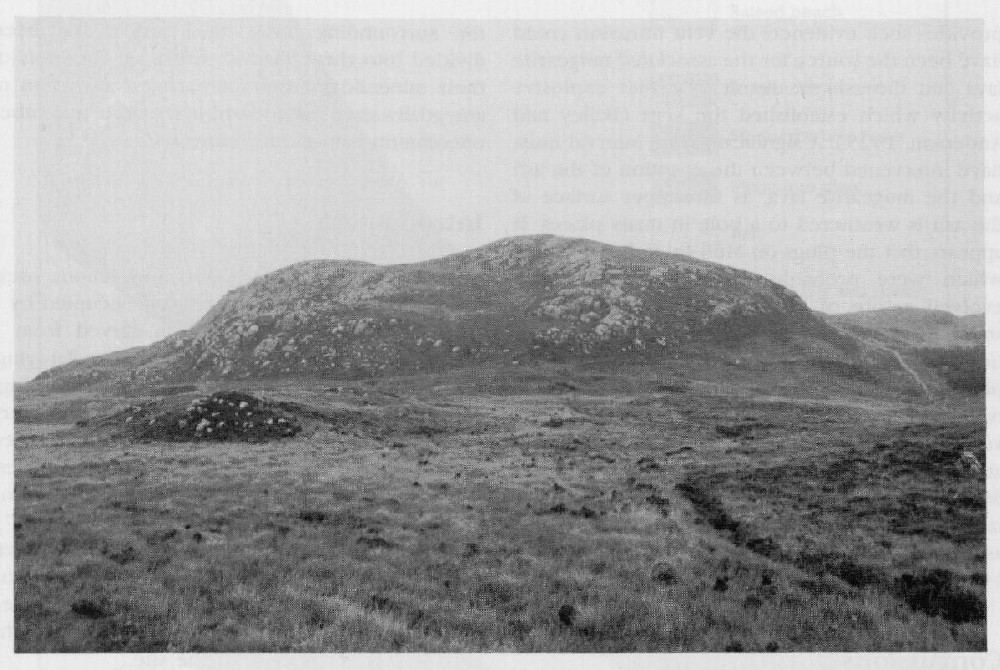'S Airde Beinn
Highlights
A large, elongate dolerite plug intrudes the lava plateau along a regional structural lineament. The plug has produced a marked thermal aureole in the surrounding lavas; the aureole has been divided into three distinct zones on the basis of their mineralogy. High-temperature alteration of amygdales gave rise to larnite, rankinite and other uncommon calc-silicate minerals.
Introduction
'S Airde Beinn is a small but conspicuous rock-girt hill with a central depression occupied by a lochan
Description
The 'S Airde Beinn plug
Interpretation
The 'S Airde Beinn plug is one of several plugs which intrude the lavas of Mull and Morvern, most of which have NNW–SSE elongations, approximately parallel to the regional dyke swarm. It also lies on a major fault zone traceable in a similar direction from Druim Fada
The principal value of the site is in the presence of the conspicuous metamorphic aureole associated with the plug. The apparent gradation from the coarse dolerite into the basalt at the contact was considered by Bailey et al. (1924) to indicate that the ascending magma which formed the plug melted and mingled with the lava wall-rock. Cann (1965), however, argued that only the most highly metamorphosed lavas have reacted with the magma. He distinguished three zones of progressive thermal metamorphism. The first is characterized initially by an increase in the amount of interstitial chlorophaeite, by the degree of alteration of pyroxene and olivine and by olivine being replaced by hypersthene and iron ore to produce a fine-grained hypersthene–augite–plagioclase–iron ore granulite. The second stage is characterized by the reappearance of olivine and an increase in granularity. Where a reaction with the magma has occurred, the third stage is reached, and olivine becomes the dominant ferromagnesian mineral.
Cann (1965) has also identified three classes of amygdale minerals on the basis of their behaviour on metamorphism. The first class consists of amygdale assemblages originally dominated by zeolite minerals such as thompsonite, natrolite and analcite with rare heulandite and stilbite. These show a consistent sequence of metamorphic change directly related to the stage of metamorphism attained by the surrounding basalts; many have been converted to plagioclase late in the first stage of metamorphism. Gyrolite is the dominant original amygdale mineral in the second class and this passes first into reyerite and then to wollastonite during metamorphism. A rim of aegirine-augite surrounds the wollastonite on its first appearance, caused by a reaction between the wollastonite and the basaltic magma. Amygdales originally filled with calcite constitute the third class. These have been altered to anhydrous calc-silicate assemblages of larnite, rankinite and wollastonite which form concentric monominer-alic zones decreasing in Ca/Si outwards. The hornfelsed basalt around the amygdales has had its composition altered by the loss of Si and, at a late stage, of Mg and Al and has gained principally Ca. In places, melilite has replaced the amygdale walls and, near the amygdales, the basalt is unusually rich in augite. Metamorphosed 'amygdales' consisting largely of ferromagnesian minerals (hypersthene, olivine, hornblende) are also present and are attributed by Cann (1965) to the infilling of vesicles or voids in partly formed amygdales during the metamorphism.
Conclusions
The 'S Airde Beinn plug caused distinctive, high-temperature alteration of the surrounding basalt lavas. Three zones of thermal alteration have been recognized in the basalts and their amygdales, on the basis of mineralogy and petrography. The formation of the calc-silicate minerals larnite and rankinite provides particularly compelling evidence for high temperatures in the aureole and there has also been reaction between the basalt lavas and the marginal dolerite at the edge of the plug. This plug, in common with others in Mull and Morvern, probably acted as a long-lived feeder for lava flows since removed by erosion. It was intruded at the same time as dykes cutting the lavas.


